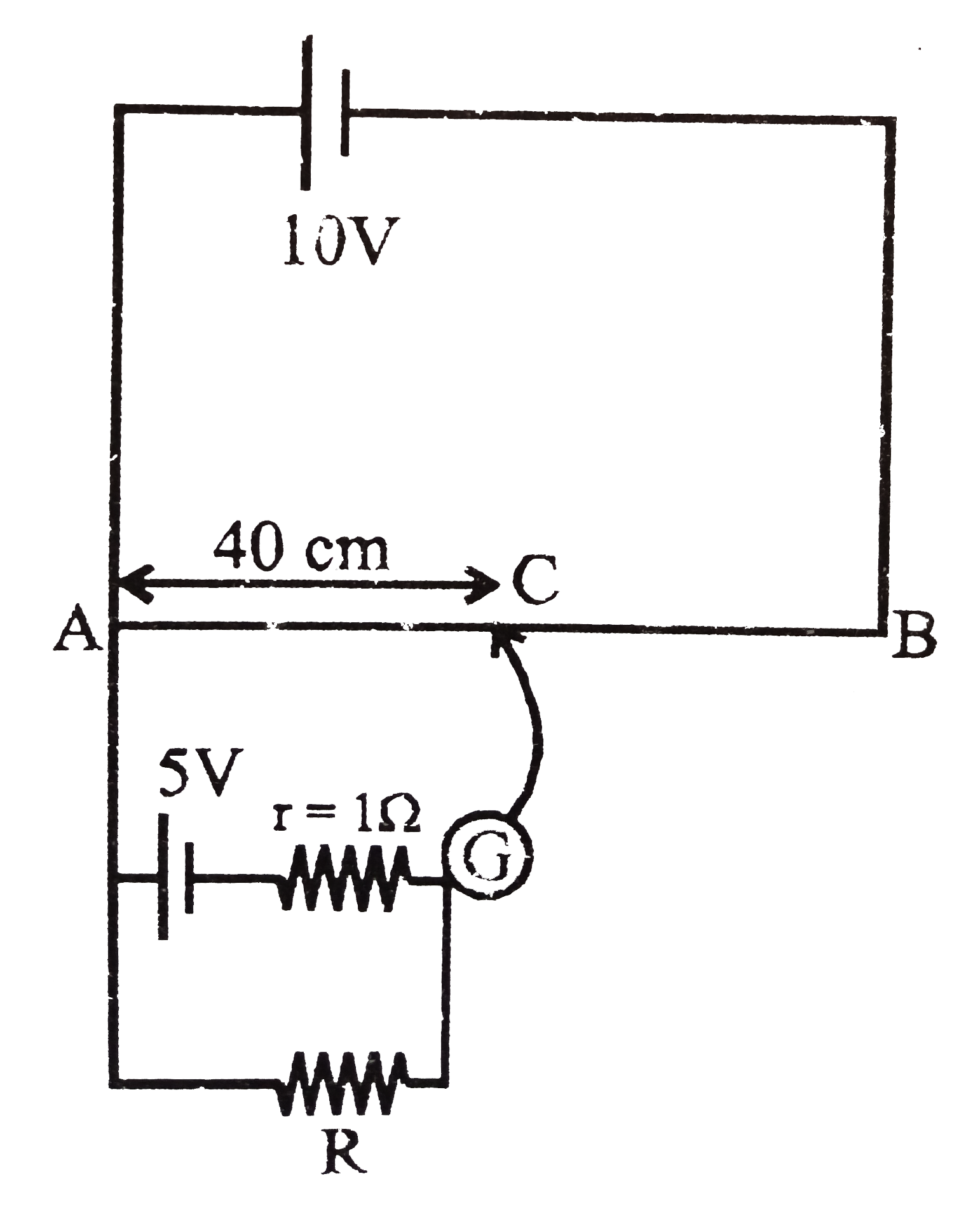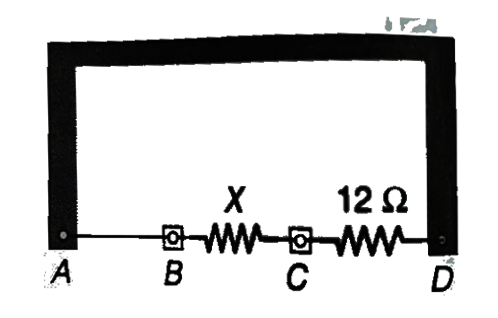The potentiometer wire AB is 600 cm long.
 a. At what distance from A should be jockey J touch the wire to get zero deflection i the galvanometer.
a. At what distance from A should be jockey J touch the wire to get zero deflection i the galvanometer.
b. If the jockey touches the wire at a distance 560cm from A, what will be the current through the galvanometer.
The correct Answer is:(a)320cm(b)3E8r
Current through potentiometer wire
I=E15r+r=E16r
potential drop across potentiometer wire
=E16r×15r=15E16
potential gradient of potentiometer wire
K=15E/16600volt/cm
(a) UIf galvanometer shown zero deffiection at length l of potentiometer wire , then
E2=K1=15E16×600I
orl=16×60015×2=320cm
(b) Fall of potential across the length 560cm=K×560 volt .If l is the current through galvanometer arm , then
K×560−E2=Iror15E16×600×560−E2=Ir
orI=3E8r
Topper's Solved these Questions
- CURRENT ELECTRICITYBOOK - PRADEEPCHAPTER - CURRENT ELECTRICITYEXERCISE - Jee (main and advance)
4 Videos
- CURRENT ELECTRICITYBOOK - PRADEEPCHAPTER - CURRENT ELECTRICITYEXERCISE - Interger Type
2 Videos
- CURRENT ELECTRICITYBOOK - PRADEEPCHAPTER - CURRENT ELECTRICITYEXERCISE - Value based
2 Videos
- COMMUNICATION SYSTEMSBOOK - PRADEEPCHAPTER - COMMUNICATION SYSTEMSEXERCISE - MODEL TEST PAPER-2
9 Videos
- DUAL NATURE OF RADIATION AND MATTERBOOK - PRADEEPCHAPTER - DUAL NATURE OF RADIATION AND MATTEREXERCISE - Exercise
191 Videos
Similar Questions
The potentiometer wire AB is 600cm long. At what distance (in cm) from A should the jockey J touch the wire to get zero deflection in the galvanometer?

View SolutionConsider the potentiometer circuit arranged as in figure.The petentiometer wire is 600cm long.(a) At wht distance from the point A should the jockey touch the wire to get zero deflection in the galvanometer?(b) If the jockey touches the wire at a distance of 560cm from A, What will be the current in the galvanometer?

View Solution
Knowledge Check
What is the magnetic induction at a distance of 5 cm from a straight wire carrying a current of 5 mA ?
A4×10−8Wb/m2B3×10−8Wb/m2C2×10−8Wb/m2D5.5×10−8Wb/m2
A potentiometer wire AB is 100cm long and has total resistance of 10Ω. If the galvanometer shows zero deflection at the position C, then find value of unknown resistance

View SolutionThe potentiometer wire AB shown in figure is 40 cm long. Where should the free end of the galvanometer be connected on AB so that the galvanometer may show zero deflection?

View Solution
The potentiometer wire AB shown in figure. Is 40 cm long. Where should the free end of the galvanometer be connected on AB so that the galvanometer may show zero deflection?
View SolutionA thin uniform wire AB of length 1m, an unknown resistance X and a resistance of 12Ω are connected by thick conducting strips, as shown in the figure. A battery and a galvanometer (with a sliding jockey connected to it) area also available. Connections are to be made to measure the unknown resistance X using the principle of Wheatstone bridge. Answer the following questions.

(a) Are there positive and negative terminals on the galvanometer ?
(b) Copy the figure in your answer book and show the battery and the galvanometer (with jockey) connected at apalphariate points.
( c) After apalphariate connections are made, it is found that no deflection takes place in the galvanometer when the sliding jockey touches the wire at a distance of 60cm from A. Obtain the value of the resistance X.
View SolutionThe potentiometer wire AB shown in figure is 40cm long. Where the free end of the galvanometer should be connected on AB so that the galvanometer may show zero deflection?

View SolutionA thin uniform wire AB of length 1m, an unknown resistance X and a resistance of 12Ω are connected by thick conducting strips, as shown in the figure. A battery and a galvanometer (with a sliding jockey connected to it) are also available. Connections are to be made to measure the unknown resistance X. Using the principle of Wheatstone bridge answer the following questions :
(a) Are there positive and negative terminals on the galvanometer?
(b) Copy the figure in your answer book and show the battery and the galvanometer (with jockey connect at appropriate points.
(c) After appropriate connections are made, it is found that no deflection takes place in th, from galvanometer when the sliding jockey touches the wire at a distance of 60cm from A. Obtain value of the resistance X.

View SolutionA thin uniform wire AB of length 1m, an unknown resistance X and a resistance of 12Ω are connected by thick conducting strips, as shown in the figure. A battery and a galvanometer (with a sliding jockey connected to it) are also available. Connections are to be made to measure the unknown resistance X. Using the principle of Wheatstone bridge answer the following questions :
(a) Are there positive and negative terminals on the galvanometer?
(b) Copy the figure in your answer book and show the battery and the galvanometer (with jockey connect at appropriate points.
(c) After appropriate connections are made, it is found that no deflection takes place in th, from galvanometer when the sliding jockey touches the wire at a distance of 60cm from A. Obtain value of the resistance X.

View Solution
